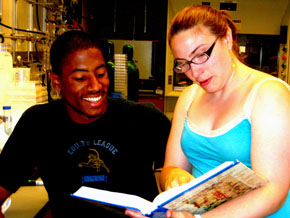
Daniel Gilmer
Howard University
Drennan Laboratory
Mentor: Christine Phillips
Summer 2007
Structural studies of Escherichia coli and Helicobacter pylori NikR
Divalent nickel is a necessary cofactor for a few life-sustaining intracellular proteins. However, Ni 2+ is toxic to the cell at high concentrations. NikR is a protein that represses the transcription of species-specific Ni 2+ importers inmany bacteria including Escherichia coli and Helicobacter pylori. NikR does not bind to DNA in the apo form, when Ni 2+ concentration in the cell is too high, Ni 2+ binds to NikR allowing NikR to inhibit the transcription of the Ni 2+ importer by binding to the nik operon. At low Ni 2+ concentration, Ni 2+ dissociates from NikR preventing NikR from binding to the operator. NikR is a tetrameric protein composed of two dimeric N-terminal ribbon-helix-helix (RHH) domains that bind DNA and a single tetrameric C-terminal metal-binding domain (MBD) that is ordered by four metal-binding sites (one on each monomer). NikR can bind divalent metals other than Ni 2+ . Crystal structures of E. coli NikR (EcNikR) bound to other divalent metals will help elucidate how these metals alter the conformation of NikR allowing it to bind to DNA. In comparing the crystal structure of E. coli NikR (previously solved) to H. pylori NikR, we will better understand the conformational flexibility and differences of NikR between organisms. We screened full-length EcNikR bound to Cd 2+ , Co 2+ , Cu 2+ , and Zn 2+ ; and the MBD bound to Cd 2+ and Co 2+ for optimum crystallizing conditions. We crystallized Ni 2+ -bound H. pylori NikR, and these crystals were taken to the synchrotron at Stanford University. Data collected from diffraction patterns will be processed in further studies.